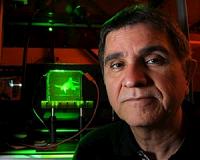 |
Washington DC (SPX) Dec 10, 2010 Versatile electronic gadgets should employ a number of important criteria: small in size, quick in operation, inexpensive to fabricate, and deliver high precision output. A new microlaser, developed at the Jozef Stefan Institute in Ljubljana, Slovenia embodies all these qualities. It is small, tunable, cheap, and is essentially the world's first practical three-dimensional laser. As described in Optics Express, an open-access journal published by the Optical Society (OSA), Slovenian scientists Matjaz Humar and Igor Mu�evic have developed a microdroplet 3-D laser system in which laser light shines forth in all directions from dye molecules lodged within spherical drops of helical molecules dispersed in a liquid solution. This is the first practical 3-D laser ever produced," says Mu�evic, who expects that the microdroplet lasers, which can be made by the millions in seconds, will be used in making arrays of coherent light emitters. These will be handy for a variety of imaging purposes, for example "internal-source holography." Here a 3-D laser would be embedded inside the object which is to be imaged; light coming directly from the source interferes with the light scattered by the surroundings. A three-dimensional image of the object can then be reconstructed from the interference pattern. The helical molecules are cholesteric liquid crystals, related to the molecules that form the backbone of liquid crystal displays. The cholesteric molecules don't mix well with the surrounding polymer liquid. This incompatibility sets up a curious condition: the index of refraction of the cholesteric liquid crystal varies periodically outwards through the body of the 15-micron-sized droplet. It's as if the droplet were an onion with the layers corresponding to materials with a different index of refraction. Most lasers possess two important ingredients: an active medium in which energy can be turned into light and amplified, and some resonant enclosure in which the developing coherent light can build up to a potent beam emerging as laser light. In the case of the microdroplet laser, the active medium consists of all those fluorescent dye molecules nestled in the liquid crystals. And the resonant enclosure consists not of the usual longitudinal shaped mirrored cavity, but of the nested sequence of "onion-layer" regions of changing index of refraction. Two more features make this laser design highly workable. First, the laser components are self-assembled. Instead of an expensive fabrication process, the parts of the laser assemble spontaneously through chemistry. Second, the laser can be tuned: by changing the pitch size of the helical molecules --the degree of their corkscrew thread-- the wavelength of the light can be altered. "Scientists have been trying to make these lasers from solid state materials, but you can imagine how difficult it is to make hundreds of alternating shells of optical materials, which should be very uniform," said Mu�evic. "The beauty of our approach is that such a 3-D onion droplet is self-assembled in a fraction of a second." To tune the laser you don't even have to replace the droplets. Their optical properties can be changed by modifying the temperature. Tuning might even be accomplished by applying an extra electric field to the drops. Last year, an early version of the 3-D laser resonator was reported. Now in the journal Optics Express, the fully tunable version of the laser is described. The paper "3D microlasers from self-assembled cholesteric liquid-crystal microdroplets" by Matjaz Humar and Igor Mu�evic appears in the journal Optics Express. It can be accessed here.
Share This Article With Planet Earth
Related Links Optical Society of America Soft Matter Space Technology News - Applications and Research
 Moving Holograms: From Science Fiction To Reality
Moving Holograms: From Science Fiction To RealityTucson AZ (SPX) Nov 08, 2010 Remember the Star Wars scene in which R2D2 projects a three-dimensional image of a troubled Princess Leia delivering a call for help to Luke Skywalker and his allies? What used to be science fiction is now close to becoming reality thanks to a breakthrough in 3D holographic imaging technology developed at the University of Arizona College of Optical Sciences. A team led by optical sciences ... read more |
|
| The content herein, unless otherwise known to be public domain, are Copyright 1995-2010 - SpaceDaily. AFP and UPI Wire Stories are copyright Agence France-Presse and United Press International. ESA Portal Reports are copyright European Space Agency. All NASA sourced material is public domain. Additional copyrights may apply in whole or part to other bona fide parties. Advertising does not imply endorsement,agreement or approval of any opinions, statements or information provided by SpaceDaily on any Web page published or hosted by SpaceDaily. Privacy Statement |